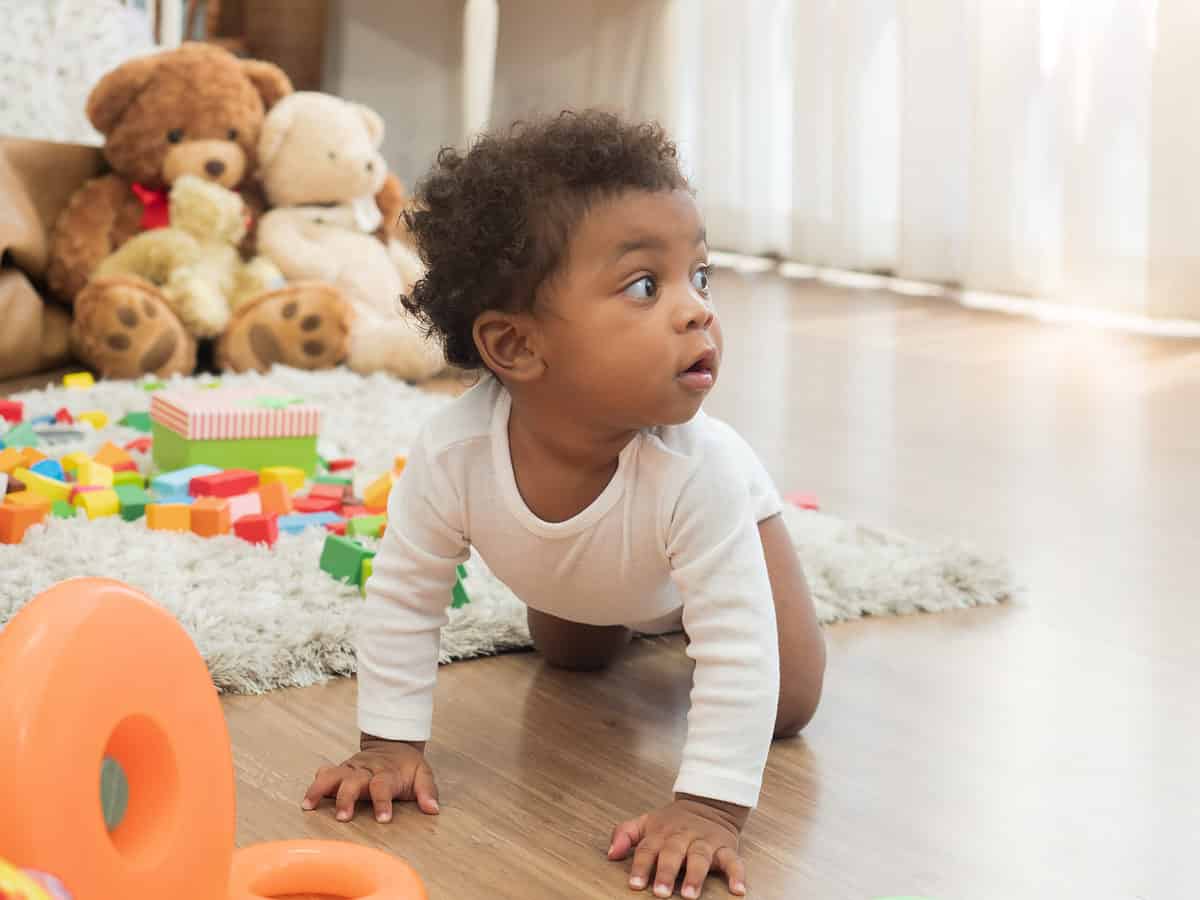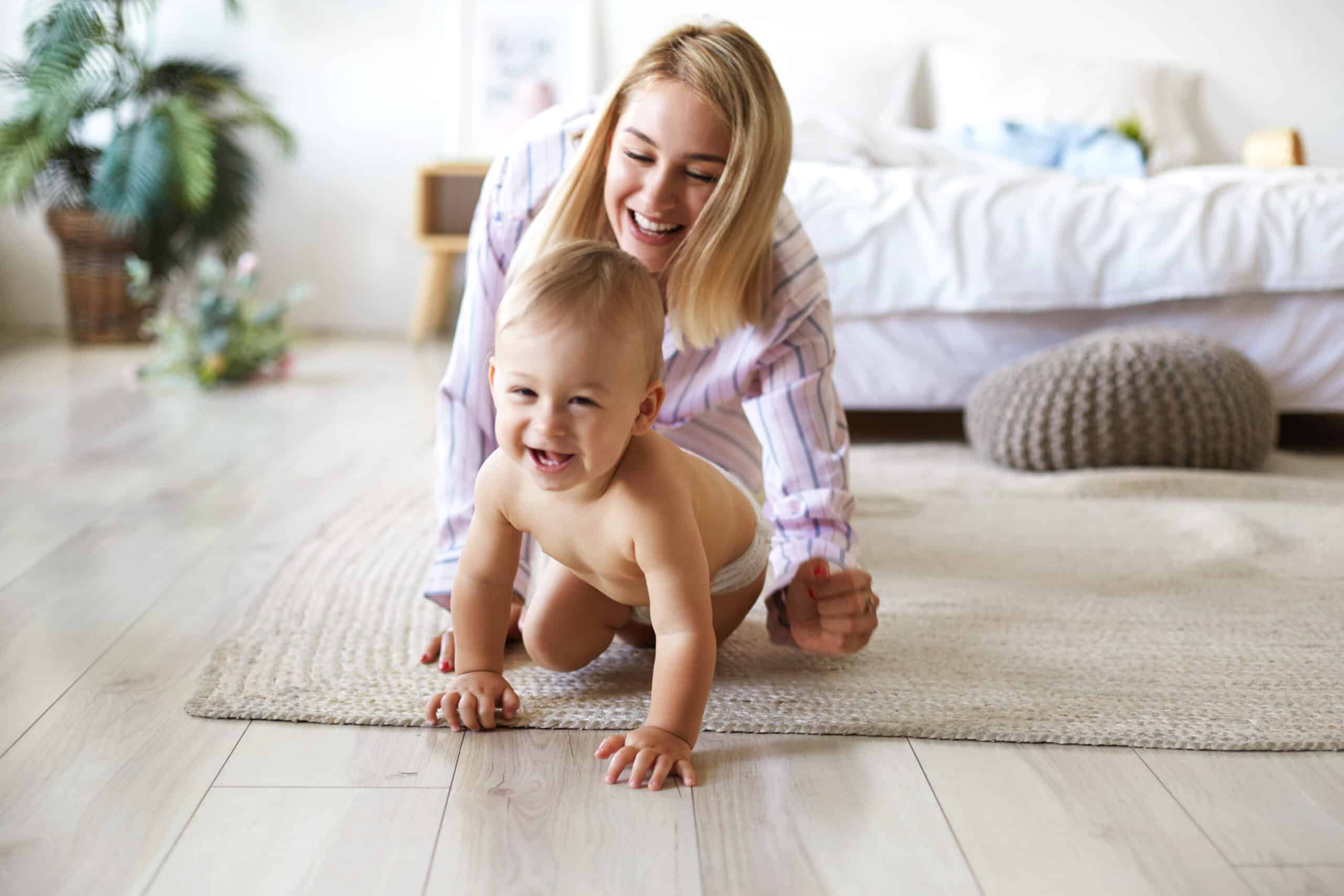In your baby’s first year, each milestone is an exciting new adventure. One of these milestones is your baby learning how to crawl. Since all infants are different, there isn’t one set age when they might start crawling. Most will learn when they’re between 6 and 9 months old, though.
Even though your baby will start crawling on their own when they’re developmentally ready, there are a few ways to encourage your baby to crawl. Tummy time can help babies get ready to crawl and encouraging them to explore the area around them can also be helpful.
There’s no reason to rush milestones like crawling since babies will start when they’re ready. But if you want to teach your baby to crawl, there are ways to help them learn. Let’s look at when crawling begins in most infants and how to tell if they’re ready.
Key Points of Babies Learning to Crawl
- Usually crawling starts around 6-11 months.
- Baby-proof your house before encouraging crawling.
- Signs of readiness include rolling, pushing up, and sitting.
- Encourage tummy time and exploring.
What Age Are Babies Supposed to Crawl?
When it comes to reaching developmental milestones, there’s usually a range instead of a set age. That’s because all babies are different! Regarding crawling, one study showed that most infants started belly crawling around 8 months old and progressed to hands and knees crawling by 10 months old. However, not all babies belly crawl first. Some babies go straight to hands-and-knees crawling.
Many babies start crawling around 8 months old but some might start as late as 10 or 11 months. Generally, the earlier a baby starts crawling, the earlier they start walking. Some babies even skip crawling altogether and go straight to pulling themselves up to standing. There’s usually no reason to be concerned if your baby is a little late with a milestone, but if they’re not showing any interest in crawling or walking by 12 months old, it may be time to discuss your baby’s progress with your pediatrician.

Giving your baby a safe and exciting place to explore can encourage them to crawl.
©Dollydoll29/Shutterstock.com
Do Babies Teach Themselves to Crawl?
As parents, it’s easy to get caught up in what’s next instead of focusing on our baby’s current stage of development. The truth is, if you don’t teach or encourage your baby to crawl, they will likely start on their own. Like many developmental milestones, crawling is something babies will figure out through trial and error. You don’t have to teach your baby to crawl, but if they’re developmentally ready, you can encourage them to start moving with some simple steps.
Signs Baby is Ready to Crawl
If you want to teach your baby to crawl, it’s important to look for signs that they’re ready. Not all babies will show every sign. However, exhibiting any of these signs is a good indicator that your baby has the strength and motor skills to start scooting along. When your baby is ready to become mobile, they may:
- Roll over from stomach to back and back to stomach.
- Rock back and forth on their hands and knees.
- Sit up unsupported.
- Push or pull themselves up from their stomachs.
Types of Crawling
As you’re waiting for your baby to start crawling, keep in mind that there isn’t only one way to crawl. There are various crawling styles that your baby may learn. Some of these crawling styles may look entirely different than your traditional hands-and-knee crawling, but this is part of each baby’s unique development. Some crawling styles include:
- Hands-and-knees crawl: babies push down on their hands and knees. They move one hand and one knee at the same time.
- Bear crawl: babies crawl with their hands and knees but keep them straight instead of bending them.
- Belly crawl: babies drag themselves across the floor on their bellies instead of pushing themselves up.
- Scooting: babies scoot across the floor on their bottom by using their arms to move.
- Crab crawl: babies move sideways with their hands like a crab.
- Rolling crawl: babies roll to move across the floor.
Preparing for Your Baby to Crawl
It’s normal to get excited about your little one crawling for the first time, but before you start encouraging them to crawl, make sure your home is a safe place for your baby. Although baby-proofing your home is important, many parents don’t do it right away since newborns don’t move around much. However, you do need to baby-proof your home before your baby starts to crawl to keep them safe.
Once they get the hang of crawling, they move faster than you think! As you’re preparing your house for this milestone, here are some things to keep in mind:
- Prepare a safe place for the baby to play. It’s not always feasible to baby-proof every area of the house right away. If you have a safe place that’s closed off by baby gates, though, that will give your baby a safe area to play in.
- Think like a baby. If it helps, put yourself down at crawling level to see what your baby sees. It may be easy to think everything is swept up or put away when you’re looking at it from a standing position, but crawling babies can easily get into things we may not notice since they’re closer to the ground.
- Keep the baby away from outlets, doors, and appliances. You can find covers or locks for things like doorknobs or outlets to easily protect your baby from unsafe areas and objects. Depending on the setup of your home, you may have to get creative with your babyproofing to ensure the baby is unable to reach anything that may be dangerous.
Babies exploring your home is a great thing, but make sure your home is a safe place for your baby to explore.
Teach Your Baby to Crawl in 5 Steps
Once your baby is ready to crawl, they may be eager to start moving around. Babies will eventually start crawling on their own when left to their devices, but you can help them learn. You don't have to teach your baby to crawl, but it can be exciting to help them learn. When you notice your baby is ready for this milestone, try these steps to get them moving.
- Practice with tummy time
Tummy time is one of the most beneficial activities to do with your baby and can be an effective way of preparing them for crawling. Tummy time has many health benefits including improved motor development. Some babies seem to dislike tummy time when they’re little, but you can start with your newborn right away to help them get used to it over time. - Don’t rely on walkers and bouncers
Many parents choose to place their baby in a walker or bouncer to encourage crawling or walking. Even though these can be a great way to keep a baby busy for a period of time, they may actually prevent your baby from developing the strength they need to crawl and walk and can even be a health hazard. Instead of placing them in their bouncer or walker, let them explore and get some time playing on the floor. - Give them something to crawl toward
When your baby is ready to move, one of the best ways to encourage them is to give them something to crawl toward. Some parents try this by putting the baby down and placing themselves just out of reach so that the baby is encouraged to crawl to their parent. You can also try this with a favorite toy or stuffed animal. - Encourage them to explore
It will be more challenging for babies to start crawling if they don’t have a safe space to practice. This is part of why baby-proofing is so important. Encourage them to explore by having a designated area with enough room to practice moving around. Place some toys in the area to keep them interested in exploring. If they’re in a chair or playpen the majority of the time, it will be more difficult for them to start crawling. - Crawl with them
What better way to teach your baby to crawl than showing them how it’s done? Even at a young age, babies love interacting and playing with their caregivers. If your baby watches you or a sibling crawl on the floor, they may imitate your movements. This can also be a great bonding time with your little one.
Takeaway
Babies grow and develop at different rates, and that’s part of what makes each baby so unique. Most infants begin crawling between 8 and 10 months although some start earlier and others start later. It’s okay if your baby isn’t mobile by the time they’re 10 months old! If they’ve reached 1 year old and still don’t show any interest in crawling, it may be helpful to talk to your pediatrician to ensure there aren’t any developmental issues.
The image featured at the top of this post is ©shurkin_son/Shutterstock.com
